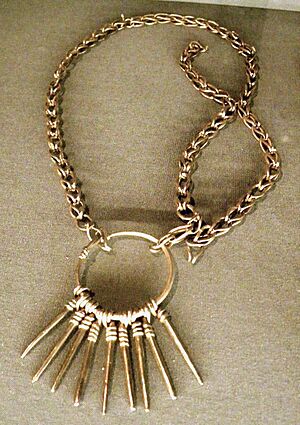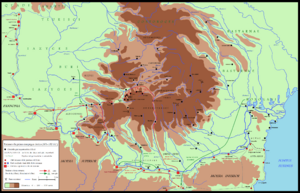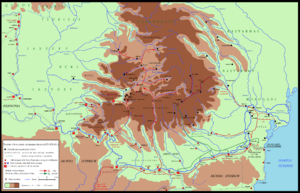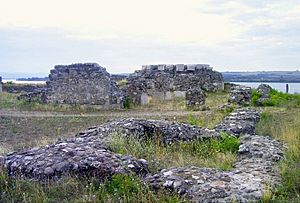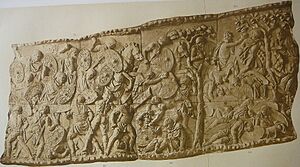Trajan's Dacian Wars facts for kids
Quick facts for kids Trajan's Dacian Wars |
|||||||||
|---|---|---|---|---|---|---|---|---|---|
| Part of the Dacian Wars | |||||||||
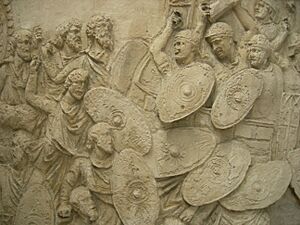 scene on Trajan's Column, possibly describing a battle between legionaries and Dacians. |
|||||||||
|
|||||||||
| Belligerents | |||||||||
Roxolani Buri Bastarnae |
Roman Empire Iazyges |
||||||||
| Commanders and leaders | |||||||||
| Decebalus | Trajan | ||||||||
| Units involved | |||||||||
| Dacian army |
|
||||||||
| Strength | |||||||||
| 200,000 Dacians Germanic and Sarmatian allies |
16 legions (between 150,000 and 175,000 infantry + auxiliary) | ||||||||
| Casualties and losses | |||||||||
| Heavy 500,000 prisoners |
Unknown | ||||||||
The Dacian Wars were two big fights between the Roman Empire and a kingdom called Dacia. These wars happened from 101 to 102 AD and again from 105 to 106 AD. They took place when Trajan was the Roman Emperor.
The Romans wanted to stop Dacia from attacking their lands near the Danube River. They also needed more resources, like gold, to help their empire's economy. These reasons led to the two major conflicts.
Contents
Why the Wars Started
For a long time, Rome wanted to keep its neighbors from causing trouble. Dacia had been a concern for Rome even before Julius Caesar's time. The Dacians had even beaten a Roman army in the past.
After an earlier war, Rome and Dacia made peace in 89 AD. Rome even paid Dacia money each year and sent skilled workers. But Dacia's king, Decebalus, used these gifts to make his own defenses stronger. He also built war machines for his army.
At this time, Rome was facing money problems. This was partly because of many military actions across Europe. Also, the Roman money had less gold in it. Rumors spread that Dacia had lots of gold and other valuable resources. This made the Romans even more interested in Dacia.
Dacia was also very strong. Many Dacian warriors had swords, which was unusual for groups outside Rome. This made Dacia a tough opponent. They had a large army and were friends with other groups Rome saw as enemies. Rome's new emperor, Trajan, was a skilled soldier. He decided to prepare for war against Dacia. Trajan even moved soldiers from other borders to fight Dacia. This shows how serious a threat Dacia was.
Trajan's First War
In 101 AD, Emperor Trajan was ready to attack Dacia. He had the Roman Senate's permission. This war showed how clever Roman soldiers and engineers were. The Roman army marched into Dacia, burning towns and villages. Trajan's forces defeated a Dacian army at the Third Battle of Tapae.
During the winter of 101-102 AD, the Roman army gathered near a city that would later be called Nicopolis ad Istrum. They were ready for an attack from the Roxolani tribe, who were allies of Dacia. The Romans won this battle.
By 102 AD, Decebalus realized he could not stop the Romans from reaching his capital, Sarmizegetusa Regia. So, he decided to make peace. Rome won this first war. They set up a military base and a governor in Sarmizegetusa.
A huge bridge, later called Trajan's Bridge, was built across the Danube River. It was designed by a famous engineer named Apollodorus of Damascus. This bridge helped the Roman army move faster into Dacia. The peace terms said Decebalus would get help from Rome to build up his defenses. This was meant to protect Dacia from other dangerous groups. However, Decebalus used these resources to rebuild his own forts and make his army stronger. Soon, he turned against the Romans again.
Trajan's Second War
After the first war, Decebalus followed Rome's rules for a while. But soon, he started encouraging other tribes to fight Rome. He also attacked Roman towns across the Danube River. Trajan, being a brave and hopeful leader, gathered his armies again in 105 AD for a second war.
This second war, like the first, had many small fights. These battles were tough for the Roman army. They faced many allied tribes and found it hard to win a clear victory. This led to another short period of peace. But Decebalus kept breaking the peace treaty. So, Rome sent in more soldiers and attacked again in 105 AD.
In 106 AD, the Romans slowly took over the mountain forts around the Dacian capital, Sarmizegetusa Regia. The final big battle happened near Sarmizegetusa in the summer of 106 AD. Roman legions like the II Adiutrix and IV Flavia Felix were part of this fight.
The Dacians fought off the first Roman attack. But a local nobleman helped the Romans find and destroy the water pipes of the Dacian capital. Without water and food, the city fell and was destroyed. Decebalus ran away, but Roman soldiers followed him. He chose to die rather than surrender to the Romans.
The war continued even after Decebalus's death. A trusted friend of the Dacian king, Bicilis, told the Romans where Decebalus's treasure was hidden. It was in the Sargesia/Sargetia river. This treasure was huge, with a lot of gold and silver. The last battle of the war took place at Porolissum.
What Happened After the Wars
Rome and its armies won the Dacian Wars. Emperor Trajan announced 123 days of celebrations across the Roman Empire. Dacia had rich gold mines, which now belonged to Rome. It's thought that Dacia gave Rome a lot of money each year. This money helped Rome pay for future wars and build new towns across Europe. You can still see signs of these old mining activities today.
One hundred thousand male slaves were sent to Rome. To stop future rebellions, two Roman legions were permanently stationed in Dacia. The southern part of Dacia was taken over by Rome and became a Roman province. The northern part remained free but never formed a strong state again.
These two wars were big wins for Rome's expansion. They made Trajan very popular. The end of the Dacian Wars started a time of growth and peace for Rome. Trajan began many building projects. He was so good at taking credit for these projects that people called him Ivy. Trajan became a respected leader, improving Rome's cities and helping the whole Empire grow stronger.
The war also changed Dacia's population a lot. In the Roman province of Dacia, most of the new people were Roman. Only a small number were Dacian. An old historian named Eutropius wrote that Trajan brought many people from all over the Roman world to live in Dacia. This was because the long war had left the land with very few people.
Most of the Dacian people now lived outside the Roman province, in an area called Transylvania. They were known as the "Free Dacians." These groups often attacked the Roman province, sometimes with the help of the Sarmatians. The Dacians who lived inside the Roman province also rebelled against Roman rule at least twice.
See also
- Dacian warfare
- Illyrian Wars
- Roman-Persian Wars
- Marcomannic Wars
- Jewish-Roman wars


